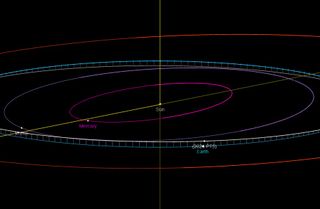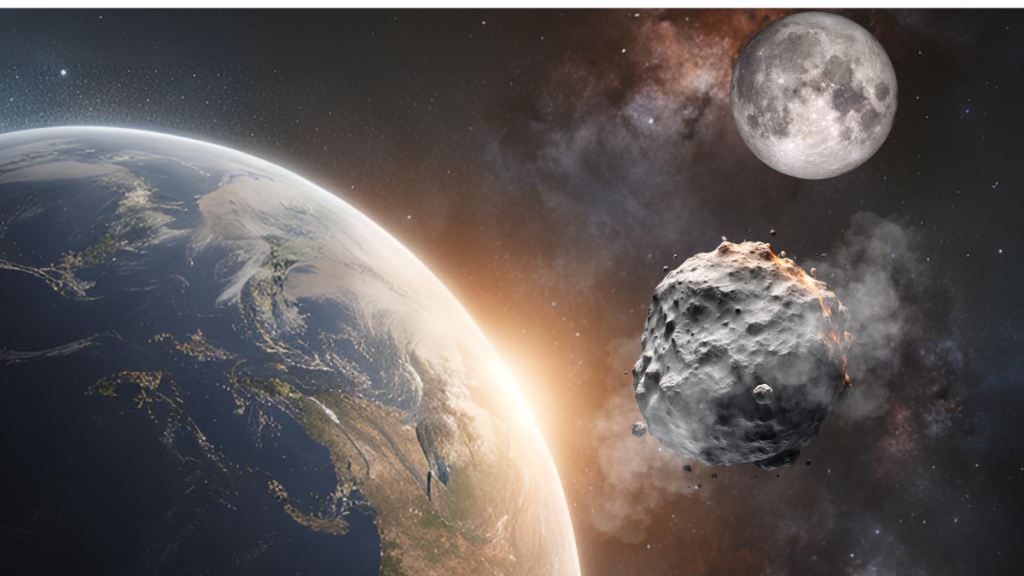Earth’s “second moon” won’t be sticking around for Thanksgiving, but just as many of us will on Thursday (Nov. 28), it seems the asteroid was paying a visit to its relatives.
Analysis of the asteroid 2024 PT5, which will leave Earth on Monday (Nov. 25), conducted during its stay around our planet, shows it may have been born from material ejected from our true moon after one of the old collisions that left the lunar surface pitted and scarred with craters.
The leading theory of moon formation, the aptly named “giant impact hypothesis,” suggests that Earth’s loyal lunar companion was born when a titanic collision around 4 billion years ago sprayed out molten material from Earth that eventually cooled and condensed. This means Earth is likely the grandparent of this “second moon,” or “mini-moon.”
“There are multiple lines of evidence suggesting that this asteroid may have a lunar origin,” Carlos de la Fuente Marcos, discovery lead author and a professor at the Universidad Complutense de Madrid, told Space.com. “Current research favors its rapid rotation with a rotational period under one hour, to be expected if 2024 PT5 is either a large boulder from the surface of the moon or a fragment from a larger object.”
The mini-moon’s lunar origin is further hinted at by its spectra, which suggest its chemical composition matches well with lunar material brought to Earth by the Russian Luna missions and NASA’s Apollo moon missions.
How Earth captured a mini-moon
The “mini-moon” asteroid originates from the Arjuna asteroid belt, a secondary asteroid belt made of space rocks that follow an orbit around the sun that’s very similar to Earth‘s orbit, dwelling at an average distance of about 93 million miles (150 million kilometers) to the sun.
“Some Arjuna asteroid belt objects can approach Earth at a close range of around 2.8 million miles (4.5 million kilometers) and at a relatively low velocity of less than 2,200 miles per hour (3,540 km per hour),” Marcos explained. “Asteroid 2024 PT5 will not describe a full orbit around Earth. You may say that if a true satellite is like a customer buying goods inside a store, objects like 2024 PT5 are window shoppers.”

Mini-moon events are divided into two categories: those with long episode stays, during which the asteroid completes one or more full orbits of our planet over the course of one or more years, and short engagements in which the small body does not complete one full revolution. These later, more temporary captures last just days, weeks, or even a few months.
Marcos said that, to become a mini-moon, an incoming asteroid has to approach Earth within a range of around 2.8 million miles (4.5 million km) and at about 2,200 mph (3,540 km per hour), a relatively slow speed.
These conditions were met by 2024 PT5 at 3:54 EDT (1954 UTC) on Sept. 29, 2024, marking the beginning of its short capture. The occupation will end at 11:43 EDT (1543 UTC) on (Nov. 25), when perturbations caused by the sun’s gravity will disrupt its orbit.
When it leaves Earth, the asteroid will return to its adoptive family of the Arjuna asteroid belt.
Marcos added that, thanks to the extensive astrometry obtained from the Teide Observatory, the determination of the orbit of 2024 PT5 has been greatly improved. That means it is now well known enough for NASA to study this object using radar when it makes another close approach to Earth on Jan. 9, 2025.
But that isn’t all scientists have learned about this mini-moon so far. As discussed, several papers have suggest that, before its adoption by the Arjuna asteroid belt, 2024 PT5 was a child of the moon, created when an asteroid struck the moon and caused material to be ejected. These findings could also suggest that other bodies in the Arjuna asteroid belt owe their origins to the moon.
“In the lunar ejecta formation scenario, 2024 PT5 could be a large boulder from the surface of the moon that was ejected into cislunar space after a cratering event, subsequently evolving dynamically towards an orbit within the Arjuna asteroid belt,” Marcos said. “This object has helped the community to realize that lunar ejecta is probably a main source for the material that constitutes the Arjuna asteroid belt.”
“I won’t really be sad to see 2024 PT5 go; mini-moons come and go as they wish. I am just waiting for the next one,” Marcos concluded. “That wait will not be long; the next capture will probably happen within the next few months. The ongoing Near Earth Object surveys are now sensitive enough to pick up these objects on a regular basis.”
Marcos is one of the authors of a new paper on 2024 PT5 and its characteristics accepted for publication in the journal Astronomy & Astrophysics and is available on the preprint repository arXiv.

